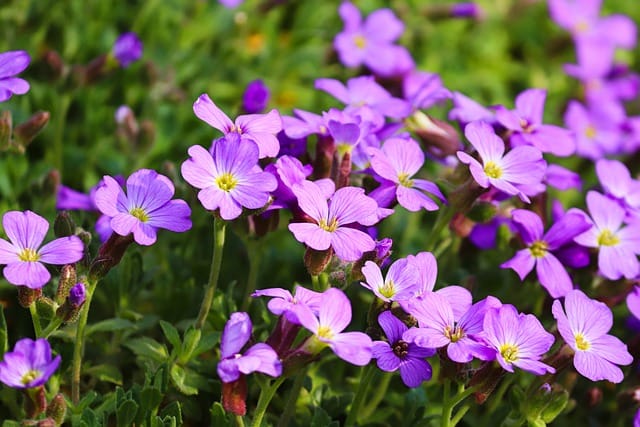How to grow Rock Cresses
The Rock Cresses flower, also known as the Aubrieta, is a beautiful perennial plant that produces stunning clusters of small, colorful flowers

In this article:
- Introduction
- Choosing the Right Variety of Rock Cresses
- Selecting an Ideal Location for Planting
- Soil Preparation and Amendment
- Propagation Methods for Rock Cresses
- Planting and Caring for Rock Cresses
- Watering and Fertilizing Requirements
- Pruning and Deadheading Techniques
- Dealing with Common Pests and Diseases
- Overwintering Rock Cresses
- Rock Cresses Companion Planting
- Harvesting and Using Rock Cresses
- Preserving Rock Cresses Seeds
- Frequently Asked Questions about Growing Rock Cresses
- Conclusion
Introduction
The Rock Cresses flower, also known as the Aubrieta, is a beautiful perennial plant that produces stunning clusters of small, colorful flowers. Known for its ability to thrive in rocky, alpine environments, the Rock Cresses flower is perfect for adding beauty and vibrancy to rock gardens, borders, and containers.
Choosing the Right Variety of Rock Cresses
There are several varieties of Rock Cresses to choose from, each with its own unique characteristics and colors. Before planting, consider the specific requirements and preferences of each variety to select the right one for your garden.
Selecting an Ideal Location for Planting
Rock Cresses prefer full sun to partial shade and well-drained soil. Look for a location in your garden that receives at least 6 hours of direct sunlight each day. Ensure the area has good drainage to prevent the plants from sitting in water, which can lead to root rot.
Soil Preparation and Amendment
Before planting, prepare the soil by removing any weeds, rocks, or debris. Add organic matter such as compost or well-rotted manure to improve the soil's fertility and drainage. Rock Cresses prefer slightly alkaline soil with a pH between 6.5 and 7.5.
Propagation Methods for Rock Cresses
Rock Cresses can be propagated through both seeds and cuttings. If starting from seeds, sow them in trays or pots filled with well-draining seed starting mix. Keep the soil moist and provide warmth until germination occurs. For cuttings, take 3-4 inch stem cuttings and root them in a well-draining medium before transplanting.
Planting and Caring for Rock Cresses
When planting Rock Cresses, space them approximately 12 to 18 inches apart to allow for their spreading growth habit. Dig a hole that is slightly larger than the root ball and gently place the plant into it. Backfill with soil, firming it gently around the plant. Water thoroughly after planting and provide regular irrigation during dry periods.
Watering and Fertilizing Requirements
Rock Cresses have moderate water needs. Water deeply and infrequently, allowing the top few inches of soil to dry out between watering sessions. Avoid overwatering, as it can lead to root rot. Fertilize with a balanced, slow-release fertilizer in early spring to promote healthy growth and abundant flowering.
Pruning and Deadheading Techniques
After the first flush of blooming, trim back the spent flowers to encourage repeat flowering. Prune back any dead or damaged stems in early spring to promote new growth. Avoid heavy pruning, as it may disturb the natural shape and growth habit of the plant.
Dealing with Common Pests and Diseases
Rock Cresses are generally resistant to pests and diseases. However, they can sometimes be affected by aphids, slugs, or snails. Monitor your plants regularly and take appropriate measures such as using organic insecticides or picking off pests by hand. Ensure good air circulation around the plants to prevent fungal diseases.
Overwintering Rock Cresses
Rock Cresses are semi-evergreen and can withstand cold temperatures. However, in areas with harsh winters, it is advisable to provide some protection. Apply a layer of mulch around the plants in late fall to help insulate the roots. You can also cover the plants with a frost cloth or burlap if frost or heavy snowfall is expected.
Rock Cresses Companion Planting
Rock Cresses go well with other low-growing, sun-loving plants such as creeping phlox, sedum, or perennial geraniums. Their cascading habit creates a beautiful contrast and adds texture to the overall garden design.
Harvesting and Using Rock Cresses
While Rock Cresses are primarily grown for their ornamental value, some varieties, like the wild Aubrieta, have edible leaves that can be added to salads or used as a garnish. Harvest the tender leaves in the morning when the flavors are most intense.
Preserving Rock Cresses Seeds
If you want to save Rock Cresses seeds for future plantings, allow the flowers to fade and dry on the plant. Once the seed pods are brown and fully mature, collect them and store them in a cool, dry place in a labeled envelope or container.
Frequently Asked Questions about Growing Rock Cresses
Q: How long does it take for Rock Cresses to bloom?
A: Rock Cresses typically bloom in late spring to early summer, but this can vary slightly depending on the variety and climate.
Q: Can Rock Cresses tolerate drought conditions?
A: While Rock Cresses can tolerate some drought, it is recommended to provide regular watering during dry periods for optimal growth and flowering.
Q: Can Rock Cresses be grown in containers?
A: Yes, Rock Cresses are well-suited for container gardening. Use well-draining soil and ensure the container has drainage holes to prevent waterlogging.
Conclusion
By following the proper techniques for choosing, planting, and caring for Rock Cresses, you can enjoy the beauty of these vibrant flowers in your garden year after year. Their ability to thrive in rocky environments and their stunning display of colors make them an excellent addition to any landscape.
